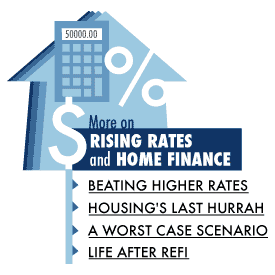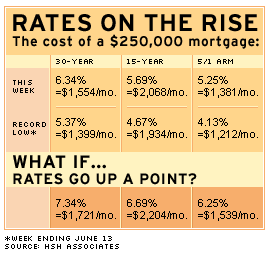NEW YORK (CNN/Money) -
If you're in the market for a new home, finding the best mortgage for you can feel a bit like finding the perfect ecru in a sea of beige. And the decision isn't made any easier in a rising rate environment.
But if you ask yourself the right questions, you can narrow your search and comparison shop more effectively.
15-year versus 30-year
The first question you should ask is, "How much can I afford on a monthly basis?"
Keep in mind, your mortgage payment is only part of what you'll pay to live in your home. You also should budget for furniture, upkeep and general expenses for things like, say, food.
Untitled

|
A 30-year mortgage will have a lower monthly payment and a higher interest rate than a 15-year mortgage. So you'll have a smaller monthly obligation but you'll pay more for your house over time because you're paying it off with interest for a longer period.
Conversely, a 15-year mortgage will have a higher monthly payment and a lower interest rate so you'll pay less for your house overall because you're paying it off sooner.
"For most home buyers, especially first-time buyers, taking a 15-year (or 20-year) mortgage is out of the question," said Keith Gumbinger, vice president for mortgage tracker HSH Associates. The higher monthly payments often are too much to handle for these types of buyers.
But for home buyers with sufficient income and a desire to be mortgage-free in a short time, a 15-year loan might be a good bet.
Fixed versus adjustable-rate
The next question: "How long will you be in the house?" You probably can't answer with certainty, but you can guess-timate.
If you're single and buying a small condo but you can envision yourself married, or you've just started a family, chances are you'll want to trade up to a new home in five to seven years. On the other hand, maybe you've had your family and want to settle into a place with a good school system, which your kids will be using for the next 12 years.

Whatever the answer, it will help you decide whether it makes sense to get a fixed-rate or an adjustable-rate mortgage (ARM).
A fixed-rate mortgage locks in a rate for the length of your loan.
ARMs, meanwhile, are short-term fixed-rate loans: After the fixed rate term is up, the rate adjusts at regular intervals in accordance with current interest rate conditions at that time. A 5/1 ARM, for example, has a fixed rate for five years and then adjusts every year for the next 25 years. (ARMs typically run on a 30-year schedule.)
The length of the fixed-rate term on an ARM typically can range anywhere from one month to 10 years. The longer the rate is fixed, the higher the interest rate you'll get. But generally speaking -- and there have been exceptions in the past -- ARMs will cost you less in the short-term. With the ARM, both your monthly payments and interest rates should be lower than either a fixed rate 15-year or 30-year mortgage.
| Your Home Resources
|

|
|
|
|
The risk with an ARM is that when interest rates rise, you could end up paying much more than you bargained for. "You're subject to the vagaries of the market," Gumbinger said. That's why in today's low-rate environment, he noted, "You want to maximize the fixed-rate picture to match your time frame."
If you know you'll be in a home for 12 years or more, a 30-year fixed rate mortgage might work better for you than, say, a 5/1 ARM, where you fix a rate for five years and then it adjusts every year after that. But if you think you won't be in the home longer than five or six years, a 5/1 ARM might make more sense.
Then there is the option of an interest-only mortgage, which is a payment option rather than a mortgage product per se. You pay only interest for a period of time, usually the first five to 15 years of a loan. Your monthly payments during that time are typically much lower than they would be with either a fixed-rate or adjustable-rate mortgage, because you're only paying interest, not principal. Plus, the rate you get is much lower than it would be on a fixed-rate product.
But once the fixed-rate period is up, your monthly payment could skyrocket both because you have to start paying down principal and your rate may adjust upward. (To read more about the pros and cons of such a loan, click here.)
A dollars-and-sense exercise
Say you need a $200,000 loan to buy a home and you can get the current average rates for a 30-year fixed, a 15-year fixed, or a 5/1 adjustable rate mortgage.
With the 30-year fixed rate at 6.44 percent, your monthly payment would be $1,256. The interest you pay over the life of your loan would total $252,252.
With a 15-year fixed rate at 5.72 percent, your monthly payment would be $1,658. The interest you pay over the life of your loan would total $98,369, or about $153,883 less than the 30-year fixed.
For more on home finance, click here
With a 5/1 ARM at 5.11 percent, your monthly payment would be $1,087 for the first five years. The total interest you pay over the life of the loan if you stayed in your home beyond five years is anyone's guess because your rate would then adjust annually. But if you move after five years, that won't be an issue.
With a five-year, interest-only mortgage at 5.11 percent, your monthly payment would be about $850. But after five years your payments would jump significantly because you would start paying down principal and rates may adjust upward. There's no way to calculate the total interest you would pay for your home, since it all depends on how long you live there and where rates are five years from now.
(This article, originally published in June, was updated Aug. 21.)

|

